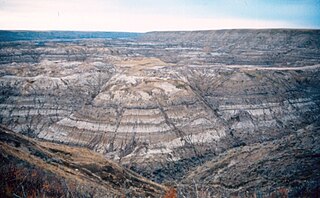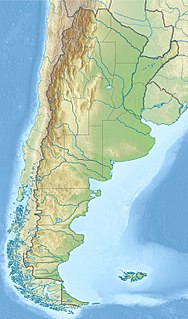Related Research Articles
Mesodma is an extinct genus of mammal, a member of the extinct order Multituberculata within the suborder Cimolodonta, family Neoplagiaulacidae. It lived during the upper Cretaceous and Paleocene Periods of what is now North America.

The Chalk Group is the lithostratigraphic unit which contains the Upper Cretaceous limestone succession in southern and eastern England. The same or similar rock sequences occur across the wider northwest European chalk 'province'. It is characterised by thick deposits of chalk, a soft porous white limestone, deposited in a marine environment.
The Maastrichtian is, in the ICS geologic timescale, the latest age of the Late Cretaceous epoch or Upper Cretaceous series, the Cretaceous period or system, and of the Mesozoic era or erathem. It spanned the interval from 72.1 to 66 million years ago. The Maastrichtian was preceded by the Campanian and succeeded by the Danian.
The Danian is the oldest age or lowest stage, of the Paleocene epoch or series, of the Paleogene period or system, and of the Cenozoic era or erathem. The beginning of the Danian age is at the Cretaceous–Paleogene extinction event 66 Ma. The age ended 61.6 Ma, being followed by the Selandian age.

Orthomerus is a genus of dubious hadrosaurid dinosaur from the Late Cretaceous of The Netherlands. It is today an obscure genus, but in the past was conflated with the much better known Telmatosaurus.

The North Horn Formation is a widespread non-marine sedimentary unit with extensive outcrops exposed in central and eastern Utah. The formation locally exceeds 3,600 feet (1,100 m) in thickness and is characterized by fluvial, lacustrine, and floodplain dominated systems, representing a terrestrial, high energy, depositional environment. The sediments date from Late Cretaceous (Maastrichtian) to early Paleocene in age and include the K-Pg extinction event boundary; however, this boundary is extremely difficult to locate and there is no strong stratigraphic evidence available that indicates a specific marker bed such as an iridium rich clay layer. Thus far, the only visible evidence is represented in the form of faunal turnover from dinosaur to mammal-dominated fossil assemblages. Taxa from the Cretaceous part of the formation include squamates, testudines, choristoderes, crocodyliforms, sharks, bony fishes, amphibians, mammals, dinosaurs, eggshell fragments, trace fossils, mollusks, plant macrofossils, such as wood fragments, and palynomorphs.
The Denver Formation is a geological formation that is present within the central part of the Denver Basin that underlies the Denver, Colorado, area. It ranges in age from latest Cretaceous (Maastrichtian) to early Paleocene, and includes sediments that were deposited before, during and after the Cretaceous-Paleogene boundary event.

The Maastricht Formation, named after the city of Maastricht, the Netherlands, is a geological formation in the Netherlands and Belgium whose strata date back to the Late Cretaceous, within 500,000 years of the Cretaceous–Paleogene boundary, now dated at 66 million years ago. The formation is part of the Chalk Group and is between 30 and 90 metres thick. It crops out in southern parts of Dutch and Belgian Limburg and adjacent areas in Germany. It can be found in the subsurface of northern Belgium and southeastern Netherlands, especially in the Campine Basin and Roer Valley Graben. Dinosaur remains are among the fossils that have been recovered from the formation.

The Tremp Formation, alternatively described as Tremp Group, is a geological formation in the comarca Pallars Jussà, Lleida, Spain. The formation is restricted to the Tremp or Tremp-Graus Basin, a piggyback foreland basin in the Catalonian Pre-Pyrenees. The formation dates to the Maastrichtian to Thanetian, thus the formation includes the Cretaceous-Paleogene boundary that has been well studied in the area, using paleomagnetism and carbon and oxygen isotopes. The formation comprises several lithologies, from sandstone, conglomerates and shales to marls, siltstones, limestones and lignite and gypsum beds and ranges between 250 and 800 metres in thickness. The Tremp Formation was deposited in a continental to marginally marine fluvial-lacustrine environment characterized by estuarine to deltaic settings.
The Hesbaye Group is a stratigraphic group in the subsurface of northeastern Belgium. This group was deposited during the early Paleocene epoch and is subdivided into two formations: the Houthem Formation (lower) and the Opglabbeek Formation (upper). The group is named after the region of Hesbaye in the south of Limburg.
The Landen Formation is a lithostratigraphic unit in the subsurface of the Netherlands. This formation shares its name with the Belgian Landen Group, but the Belgian unit is thinner and has different definitions. The Landen Formation consists of shallow marine and lagoonal sediments from the late Paleocene to early Eocene. Dutch stratigraphers see the Landen Formation as part of the Lower North Sea Group.
The Hannut Formation is a geologic formation in the subsurface of northern Belgium. The formation consists of marine clay and silt, alternating with moer sandy layers. On top of this the lithology changes to limestone, siltstone and sandstone and the top of the formation is formed by a layer of glauconite bearing sand. The Hannut Formation was formed during the early to middle Thanetian age.
The Heers Formation is a geologic formation in the subsurface of Belgium. The formation consists of sand and marl and was deposited in the shallow sea that covered Belgium during the middle to late Selandian age of the Paleocene epoch.
The Dongen Formation is a geologic formation in the subsurface of the Netherlands. The formation consists of early Eocene marine clay and sand. It is named after the town of Dongen in North Brabant.
The Tongeren Formation is a geologic formation in the subsurface of the Netherlands. The formation consists of shallow marine, epicontinental and continental sediments, predominantly clay and sand from the late Eocene and early Oligocene epochs. The Tongeren Formation is part of the Middle North Sea Group and correlates with the Tongeren Group from Belgian stratigraphy.
The Maldegem Formation is a geologic formation in the Belgian subsurface. The formation consists of alternating marine clay and sand strata, deposited during the late Eocene.

The Edmonton Group is a Late Cretaceous to early Paleocene stratigraphic unit of the Western Canada Sedimentary Basin in the central Alberta plains. It was first described as the Edmonton Formation by Joseph Burr Tyrrell in 1887 based on outcrops along the North Saskatchewan River in and near the city of Edmonton. E.J.W. Irish later elevated the formation to group status and it was subdivided into four separate formations. In ascending order, they are the Horseshoe Canyon, Whitemud, Battle and Scollard Formations. The Cretaceous-Paleogene boundary occurs within the Scollard Formation, based on dinosaurian and microfloral evidence, as well as the presence of the terminal Cretaceous iridium anomaly.

The Ojo Alamo Formation is a geologic formation in New Mexico spanning the Mesozoic/Cenozoic boundary.

The Jagüel Formation is a geological formation, located in Patagonia, Argentina. It underlies the Roca Formation and overlies the Allen Formation. All of these formations belong to the Malargüe Group. Its name was coined by Windhausen in 1914. This unit, defined in the eastern area of the Neuquén Embayment, registers an event of marine flooding that happened during the ages Maastrichtian and Danian. It consists of mudrocks formed between the upper section or "Gypsum" of the Allen Formation, and the base of the first organogenic limestone of the Roca Formation. The Jagüel Formation is particularly important since a vast area of the formation contains the Cretaceous–Paleogene boundary that marks the end of the Mesozoic Era. It also shows evidence of the Cretaceous–Paleogene (K–Pg) extinction event. In this period of time, animal species became extinct, such as non–avian dinosaurs, the last marine reptiles, ammonites, and many groups of microfossils.

The Lefipán Formation is a Maastrichtian to Danian, straddling the Cretaceous-Paleogene boundary, geologic formation of the Cañadón Asfalto Basin in Chubut Province, Patagonia, Argentina. The up to 380 metres (1,250 ft) thick stratigraphic unit comprises mudstones, sandstones, siltstones and conglomerates, sourced from the North Patagonian Massif and deposited in a deltaic to shallow marine environment with a strong tidal influence. The basin that in those times was connected to the widening South Atlantic Ocean with a seaway connection to the Austral Basin and possibly with the Pacific Ocean.